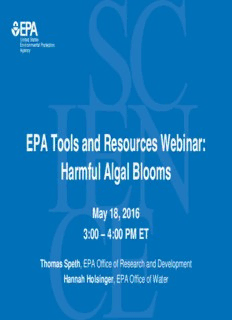
Harmful Algal Blooms Webinar Slides PDF
Preview Harmful Algal Blooms Webinar Slides
EPA Tools and Resources Webinar: Harmful Algal Blooms May 18, 2016 3:00 – 4:00 PM ET Thomas Speth, EPA Office of Research and Development Hannah Holsinger, EPA Office of Water Part 1: EPA’s Research on the Control of Cyanobacterial Toxins Thomas Speth, PhD, PE EPA Office of Research and Development 2 Background Complex Issue: Septic 7% Excessive nitrogen and phosphorous levels can cause harmful algal blooms Urban 10% Different algal/cyanobacteria strains bloom under different conditions, at different times, and have spatial variability (horizontal and vertical) Pasture Different strains produce different toxins at varying 14% Crop Land amounts 65% Different analytical methods tell different pictures of what is going on Toxins can be intracellular (within algae itself) or extracellular (dissolved in the water) Nitrogen Load Source Drinking water treatment is a balancing act between Distribution to Harsha Lake in processes Ohio 3 Cyanobacteria Strains & Associated Toxins Cyanobacteria Taxa Strains produce different toxins at different amounts Toxins can have multiple variants Example: Over 80 known microcystin variants Toxins analyzed by USEPA (544 and 545) 4 Spatial Issues: 2015 Ohio River Bloom Little consistency over small or large scale Source: Ohio River Sanitation Commission Spatial Issues: 2015 Ohio River Bloom Lake Erie Depth Red: Shallow Blue: Deep West East Source: National Oceanic and Atmospheric Administration 7 August 2014 Lake Erie Bloom Cyanobacteria Index Sources: National Oceanic and Atmospheric Administration; National Aeronautics and Space Administration August 2015 Lake Erie Bloom Cyanobacteria Index Sources: National Oceanic and Atmospheric Administration; National Aeronautics and Space Administration Lake Erie DW Treatment Plant Study Field Studies • Monitoring cyanobacteria toxins through numerous treatment plants on Lake Erie Lake Erie • Parameters (not inclusive) • NO /NO /NH 3 2 3 • PO 4 • TOC/Total N • Total alkalinity • Trace metals by ICP • Toxins (Microcystins, Cylindrospermopsin, Anatoxin, Saxitoxin) Bench- and Pilot-Scale Studies • Bench-scale permanganate, ozone, and activated carbon trials • Pilot installation in Toledo, OH 10
Description: